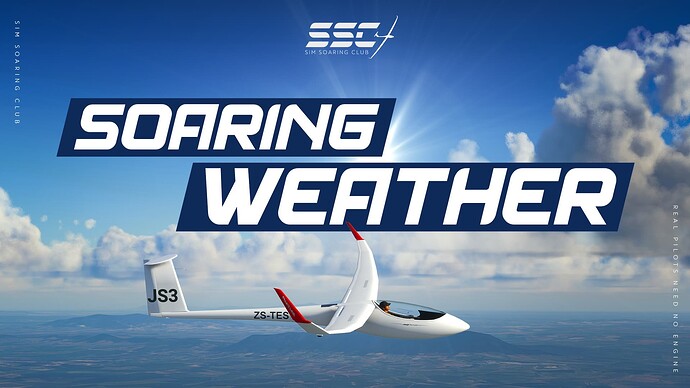Download on https://flightsim.to/file/56827/soaring-weather
The goal of these presets is to provide flyable conditions, in a wide variety of geographical locations, be it over flat terrain or in the mountains and at the same time maintain a realistic look of the weather.
To achieve this goal we optimised relevant variables and created workarounds for various MSFS quirks.
After hundreds of hours of research and feedback from real pilots we believe to have found a compromise that best mitigates the current issues with lift in MSFS.
This download contains 8 variations of the SSC Soaring Weather preset, for 8 different wind directions, allowing you to glide anywhere in the world.
How to install:
Simply copy the .WPR files to the correct location and select them in-game from the weather presets menu.
MS Store version: C:\Users\Admin\AppData\Local\Packages\Microsoft.FlightSimulator_[random-letters-&-numbers]\LocalState\Weather\Presets
Steam version: C:\Users[Your Name]\AppData\Roaming\Microsoft Flight Simulator\Weather\Presets
To successfully fly long distances in a glider it is important to understand the weather in MSFS.
The SSC Soaring Weather features 2 sources of lift for glider pilots:
1. Thermals (rising air associated with clouds)
2. Ridge lift (created by wind flowing over mountains)
Prerequisites:
In order to find decent thermals, flights should be done in summer around noon hours.
Time of Day and Season play a big role in determining the thermal strength.
These factors are not part of the presets and have to be set by the pilot himself.
Thermals:
The presets include clouds that feature thermals of up to 10 knots of vertical wind below cloud base at 2000 m above ground level, and slowly decreasing the higher you fly above cloud base.
Due to how msfs works, these thermals can be found a little offset to the windward side of the cloud (not directly below the cloud). The larger, higher and denser the cloud is looking, the bigger is the chance to find good lift.
MSFS also simulates hot air rising from the sun heating terrain, but this is completely independent from cloud formation, and cannot be controlled by a weather preset, as it solely depends on the time of day, season and wind speed among other things.
Ridge lift:
MSFS is doing an ok job at simulating air flowing over mountains, with the exception of the fact that under many circumstances lift can be found at altitudes high above the ridges, which is quite unrealistic.
To work around this fact, the presets are set up in AGL mode, featuring several wind layers at different altitudes above ground level (as opposed to altitude above sea level).
To produce ridge lift, you will find wind speeds of around 15 kts close to the surface (be it in a valley or on a mountain peak). As in real life this lift only reaches a couple of 1000 ft above the terrain, due to the addition of multiple wind layers of decreasing wind speeds in the preset, meaning you have to fly pretty close to the mountains in order to benefit from the ridge lift.
Note:
These weather presets control the lift by manipulating the wind so you will see wind speeds reducing significantly as you rise above slopes but this seems the optimal compromise to get realistic ridge-lift conditions.
They were designed to work universally for thermal- and ridge soaring. Feel free to finetune the windlayers and cloud altitudes for your specific flights.
Tips:
- For best conditions fly during summer at noon.
- Pick a preset with a favourable wind direction depending on your flight plan.
- Find thermals on the windward side of clouds (not directly under clouds).
- For best lift in the mountains fly between 500 - 1500 feet above the ground.
- Fly over terrain easily heated by the sun (cities, rocks, beaches)
- Consider setting the Turbulence option to medium for a smoother flight (Assistance Settings>Piloting)
The Sim Soaring Club is a friendly community of over 1300 pilots, flying gliders in MSFS and hosting multiple group flights every week.
Join us on discord: Sim Soaring Club
Contributing pilots:
ANRI, B21, Biggles, Georg & all active members of the Sim Soaring Club.
Happy Soaring!

